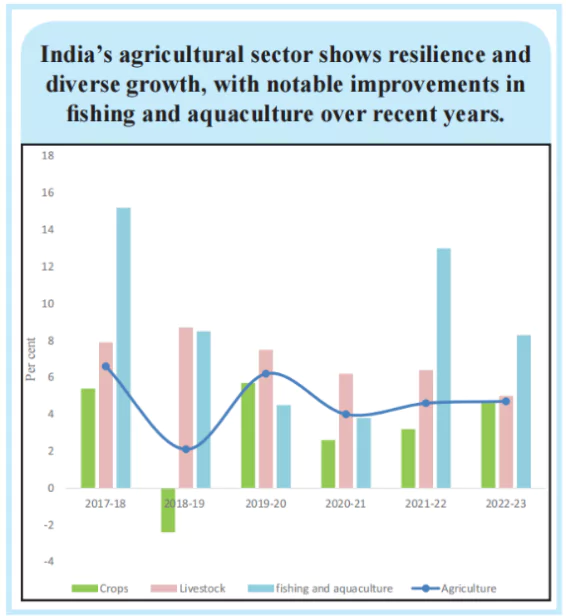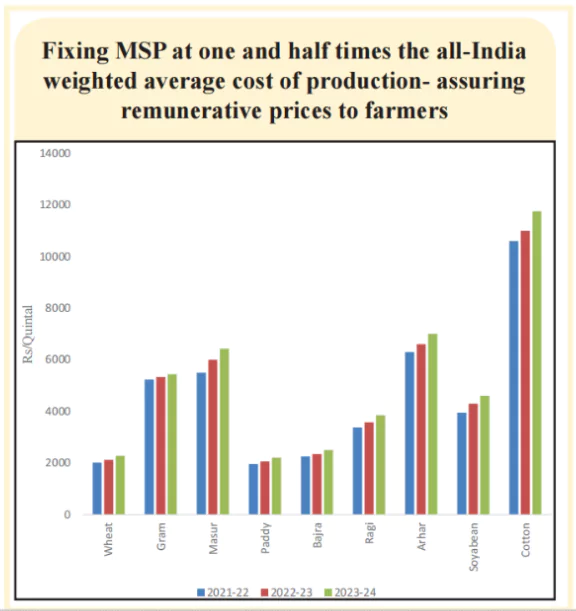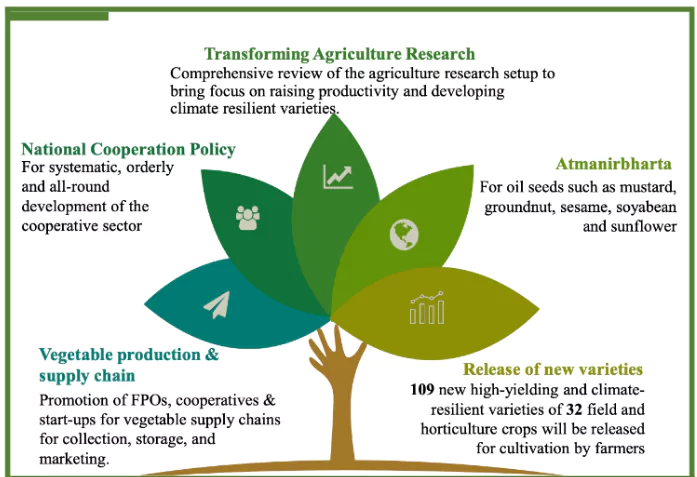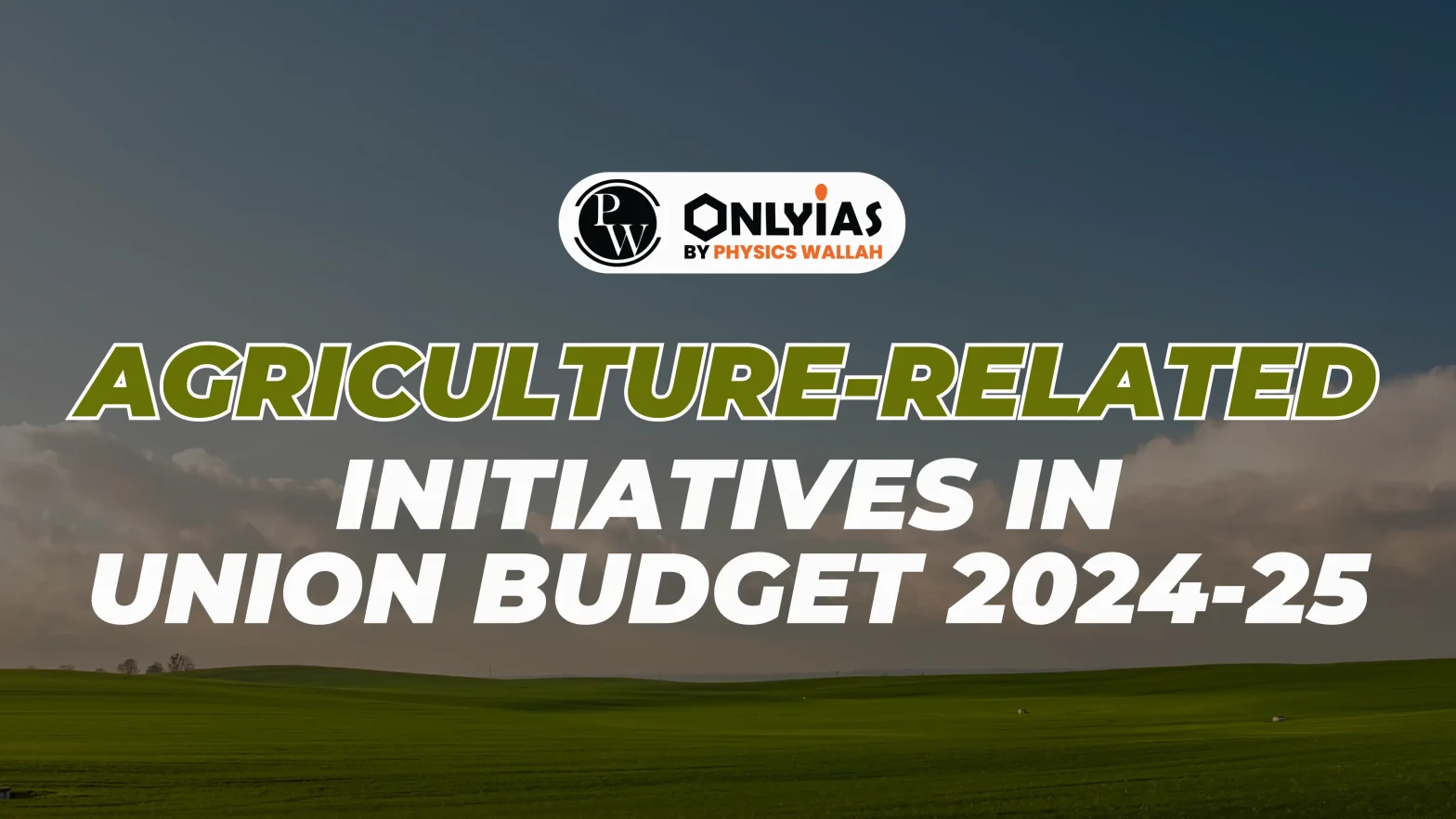Recently, the Finance Minister in budget 2024 has provided a roadmap for the pursuit of Viksit Bharat @2047 with agriculture as a key priority.
Budget for Agriculture
- Economic Growth:
- In 2023-24, the Indian economy registered an overall GDP growth rate of 8.2 per cent, and it is likely to remain above 7 per cent in FY25 according to most projections.
- Allocation in agriculture and allied sectors: The budget has allocated Rs 1.52 trillion for the agriculture and allied sectors.
- Ministry of Agriculture and Farmers’ Welfare: It has received a budget of Rs 1.22 trillion (BE), an increase of just 5 per cent – This barely compensates for inflation.
- Ministry of Fisheries, Animal Husbandry and Dairying: The allocation to the ministry has increased 27 per cent – Rs 56 billion (RE) in FY24 to Rs 71 billion (BE).
Enroll now for UPSC Online Course
About Agriculture Sector
- Agriculture Sector: The agriculture sector encompasses all activities related to the production, processing, and distribution of food, fiber, and other agricultural products.
- Significance: The Indian agriculture sector provides livelihood support to about 42.3 percent of the population and has a share of 18.2 per cent in the country’s GDP at current prices.
- Agricultural Development in India: Ministry Structure and Initiatives
- Ministry of Agriculture and Farmers Welfare is made up 2 departments and implements National Policy for Farmers (2007)
- Dept of Agriculture:
- Department of Agriculture, Cooperation and Farmers Welfare
- Statutory Bodies/Boards – Coconut Development Board, National Cooperative Development Corporation, Protection of Plant Varieties and Farmers’ Rights Authority, Registrar of Multi State Cooperative Societies.
- Attached Office – National Rainfed Area Authority.
- CPSE – National Seeds Corporation Ltd. (NSC)
- Autonomous / Cooperative bodies: NAFED, Small Farmers Agribusiness Consortium (SFAC). Various boards / institutes for horticulture, plant health management, Agro marketing etc.
- Dept of Agro Research Extension:
- Department of Agricultural Research & Education
 Autonomous body: Indian Council of Agricultural Research (ICAR)
Autonomous body: Indian Council of Agricultural Research (ICAR)- Central Agro universities at Imphal (Manipur), Pusa (Bihar), Jhansi (UP).
- Agricultural Growth in FY23: Average annual growth rate of 4.18% at constant prices over the last five years.
- Growth in the agriculture sector declined from 4.7 per cent in FY23 to 1.4 per cent in FY24.
- India is the largest producer of milk pulses and spices and the second largest producer of rice, wheat, cotton, and the fruits, vegetables and sugar.
- Livestock Sector: Contribution of livestock to the total GVA (at constant prices) in agriculture and allied sectors increased from 24.32 per cent in 2014-15 to 30.38 per cent in 2022-23.
- Fisheries Sector: In 2022-23, India achieved a record fish production of 17.54 million tons, ranking third globally and accounting for 8 percent of global production.
- Food Processing Sector: The share of processed food exports increased from 14.9 per cent in 2017-18 to 23.4 percent in 2022-23.
 Allied Sectors: Emerging as robust growth centers and promising sources for improving farm incomes.
Allied Sectors: Emerging as robust growth centers and promising sources for improving farm incomes.- Agricultural Credit: Total credit disbursed to agriculture: ₹22.84 lakh Crore as of January 31, 2024.
- Kisan Credit Card (KCC): 7.5 crore KCCs issued with a credit limit of ₹9.4 lakh Crore as of January 31, 2024.
- Pradhan Mantri Kisan SAMPADA Yojana (PMKSY) introduced credit-linked financial assistance through grants-in-aid.
- Agriculture Infrastructure Fund(AIF) provides medium-term debt financing.
Agriculture-Related Initiatives in Union Budget 2024-25
Research & Development: Government will undertake a comprehensive review of the agriculture research setup to bring the focus on raising productivity.
Productivity in agriculture:
- It refers to the efficiency with which agricultural inputs (such as land, labor, fertilizers, seeds, and water) are converted into outputs (such as crops, livestock, and other agricultural products).
- Higher productivity means more output is produced from the same amount of inputs, indicating a more efficient use of resources.
- China’s yield of grain production is higher than that of India’s
|
- Agricultural Research Investment: Estimated payoff of ₹13.85 for every rupee invested in agricultural research (including education).
- Transforming Agriculture Research: By implementing comprehensive review of the agriculture research setup to bring focus on raising productivity and developing climate resilient varieties.
Check Out UPSC CSE Books From PW Store
Krishi Vigyan Kendras (KVKs)
- KVKs are agriculture extension centres in India.
- They are present in every district of the country, have a large network, and participate in on-farm testing to assess the location specificity of agricultural technologies, as well as demonstrations to establish the production potential of technologies on farmers’ fields.
|
-
- Strengthening of Krishi Vigyan Kendras (KVKs): It saw an outlay of Rs 234.89 crore in the Budget.
- Funding: It will be provided in challenge mode, including to the private sector. Domain experts both from the government and outside will oversee the conduct of such research.
- Release of new varieties: New 109 high-yielding and climate-resilient varieties of 32 field and horticulture crops will be released for cultivation by farmers.
 National Cooperation Policy: The government will bring out a National Cooperation Policy for systematic, orderly and all-round development of the cooperative sector.
National Cooperation Policy: The government will bring out a National Cooperation Policy for systematic, orderly and all-round development of the cooperative sector. -
- Policy Goal:
- Fast-tracking growth of rural economy and
- generation of employment opportunities on a large scale
- 1.52 lakh crore has been allocated for agriculture and allied sectors this year.
- Atmanirbharta: For oil seeds such as mustard, groundnut, sesame, soyabean and sunflower
- Vegetable Production & Supply Chain: Promotion of FPOs, cooperatives & start-ups for vegetable supply chains for collection, storage, and marketing.
- Initiatives: Large scale clusters for vegetable production will be developed closer to major consumption centres.
- It will promote Farmer-Producer Organizations, cooperatives and start-ups for vegetable supply chains including for collection, storage, and marketing.
What are Farmer Producer Organisations (FPOs)?
- An FPO is a collective of farmers with holdings or works in a geographical cluster.
- It can be registered under the Companies Act or as a cooperative under the Societies Registration Act.
|
- Major Boost to Pulses / Oilseeds Procurement: India currently imports about 15 per cent of its pulses consumption and about 56 per cent of its total annual edible oil consumption.
-
- In absolute figures, the sector saw an increase of Rs 5,804.3 crore, and 73 per cent of that increase has gone to one scheme: Pradhan Mantri Annadata Aay Sanrakshan Yojna (PM-AASHA).
- This is likely to give a fillip to procurement of pulses and oilseeds from farmers at fixed floor prices.
Pradhan Mantri Annadata Aay SanraksHan Abhiyan (PM-AASHA)
- It is an umbrella scheme aimed at ensuring remunerative prices to the farmers for their produce.
- Components of PM-AASHA
- Price Support Scheme (PSS) – Physical procurement of pulses, oilseeds and Copra will be done by Central Nodal Agencies with a proactive role of State governments.
- The procurement expenditure and losses due to procurement will be borne by the Central Government as per norms.
- Price Deficiency Payment Scheme (PDPS)- It is proposed to cover all oilseeds for which MSP is notified. In this direct payment of the difference between the MSP and the selling/model price will be made to pre-registered farmers selling his produce in the notified market yard through a transparent auction process.
- This scheme does not involve any physical procurement of crops as farmers are paid the difference between the MSP price and Sale/model price on disposal in the notified market.
- Pilot of Private Procurement & Stockist Scheme (PPPS): It has also been decided that participation of private sector in procurement operation needs to be piloted so that on the basis of learnings the ambit of private participation in procurement operations may be increased.
- The pilot district/selected APMC(s) of the district will cover one or more crops of oilseeds for which MSP is notified.
- Since this is akin to PSS, in that it involves physical procurement of the notified commodity, it shall substitute PSS/PDPS in the pilot districts.
|
- Natural Farming:
- Certification and branding: One crore farmers across the country will be initiated into natural farming supported by certification and branding.
- 10,000 need-based bio-input resource centers will be established.
- Digital Public Infrastructure for Agriculture
- Central government, in partnership with the states, will facilitate the implementation of the Digital Public Infrastructure (DPI) in agriculture for coverage of farmers and their lands in 3 years.
- Key Initiatives:
- Digital Crop Survey: Conducted for Kharif in 400 districts this year.
- Farmer and Land Registries: The details of 6 crore farmers and their lands will be brought into the farmer and land registries.
- Kisan Credit Cards: Jan Samarth based Kisan Credit Cards will be enabled in 5 states.
- Shrimp Production & Export
- Breeding Centres for Shrimp: The Union Finance Minister said Financial support for setting up a network of Nucleus Breeding Centres for Shrimp Broodstocks will be provided.
- NABARD: Financing for Shrimp farming, processing and export will be facilitated through NABARD.
- Rural Land Related Actions: These actions will facilitate credit flow and other agricultural services. It will include:
- Assignment of Unique Land Parcel Identification Number (ULPIN) or Bhu-Aadhaar for all lands
- Digitization of cadastral maps
- Survey of map sub-divisions as per current ownership
- Establishment of land registry
- Linking to the farmers registry
Check Out UPSC NCERT Textbooks From PW Store
Associated Challenges
- Modest Rise in Agriculture Research Funding: The budget allocation for the Department of Agricultural Research and Education for 2024-25 has seen a marginal increase of just 0.6 per cent from the revised estimates of the previous fiscal year, 2023-24.
- This modest rise has raised concerns among stakeholders about the adequacy of funding to support the proposed advancements in agricultural research.
- Agriculture Research Intensity (ARI): The ARI peaked at 0.75 per cent in 2008-09 and stands at 0.43 per cent in 2022-23.
Agriculture Research Intensity (ARI)
- It is a metric used to measure the level of investment in agricultural research relative to the size of the agricultural sector.
- It is typically expressed as a ratio of agricultural research and development (R&D) expenditures to agricultural gross domestic product (GDP).
|
-
- This will fall further in FY25, as the allocation to this segment has gone down in real terms.
- This is not good news for the country’s food security as well as for arresting food inflation.
- Slight Increase: The Budget allocated Rs 1.52 lakh crore to agriculture and allied sectors, a slight increase from the allocation of Rs 1.25 lakh crore in the previous budget.
- However, the share of agriculture in the total budget is a mere 3.1 per cent in a country where almost 2/3rd of the population is engaged with agriculture.
- Disparity between Grand Announcements and Declining Financial Provisions:
- Reduced allocation for the interest subvention scheme for agricultural credit, linking it to the ongoing crisis of farmer suicides due to indebtedness.
- Less Investment: New ‘Namo Drone Didi’ scheme, which promotes the use of agrochemicals, has been allocated Rs 500 crore
- In the Budget 2023-24: A ‘National Mission on Natural Farming’ was also announced with a meagre budget of Rs 459 crore.
- The revised expenditure is Rs 100 crore only. However, instead of increasing the allocations of the scheme, it is further reduced to Rs 365.6 crore for 2024-25.
- Government’s Failure to Fulfill Past Promises: Such as the revival of 22,000 rural haats under Gramin Agricultural Markets scheme and the establishment of 10,000 farmer producer organisations.
- Budgetary support for PM-Kisan Samman Nidhi and Mahatma Gandhi National Rural Employment Guarantee Scheme has also dwindled, with allocations falling to Rs 60,000 crore and Rs 86,000 crore, respectively.
- Transparency Issues: 10 million farmers will be initiated into natural farming supported by certification and branding.
- However, there is no information on the progress of the 2023-24 budget commitment that ensured the same number of farmers to adopt natural farming within three years.
- MSP Demand Unheard: The demand for a legal Minimum Support Price (MSP) has been long overdue and remains a point of contention between farmers and the government.
- This issue, however, has not been addressed.
- Legalising MSP for a broader range of crops could potentially diversify crop production, enhance farmers’ livelihoods and benefit the climate.
- Doubling Farm Income: The DFI 2016 report indicated that to double farmers’ income over the period of 2016-17 to 2022-23, income would need to grow at an annual rate of 10.4 per cent in the farm sector, which in turn would require an annual growth rate in agriculture investment of 12.5 per cent
- Compensation: Until the farmers are compensated for their crop losses, neither will their incomes grow nor will there be any progress in the Indian agriculture sector.
- Improving post-harvest storage capacities and augmenting the rudimentary agricultural infrastructure is crucial to reducing these losses.
- Farmers in the country cannot sell all their produce in the market: Horticulturists particularly suffer the most significant losses as they do not reap economic benefits. Farmers producing fruits cannot sell 34 per cent of their produce, while those growing vegetables cannot sell a whopping 44.6 per cent.
- Reason: The major reasons for post-harvest losses include insufficient cold chain facilities, poor infrastructure, inadequate storage capacity, and transportation-related losses.
Way Forward
- Lab to Land Gap: Agricultural scientists to close the “lab to land” gap, stressing the need for practical application of research innovations to benefit farmers directly.
- Increase Budget Allocation: Advocate for higher budget allocations by demonstrating the direct correlation between agricultural research investment and productivity, food security, and economic growth.
- Focus on Agri-R&D: Prioritize funding for research areas with the potential for the highest impact on productivity and sustainability.
- The best way to improve productivity and increase climate resilience would have been to focus on agri-R&D.
- It’s well known that the marginal returns of investing in agri-R&D are over 10 times – in other words, an extra investment of 1,000 crore will mean Rs 10,000 crore in terms of agri-GDP.
- Strengthen Research Institutions: Enhance the capacity of existing agricultural research institutions through better infrastructure, funding, and human resources.
- Transparent Budgeting: Ensure transparency in budget allocation and spending to build trust among stakeholders.
- Focus on Investment: Increase investment in agriculture to meet the required growth rate for doubling farmers’ income.
- Compensation for Losses: Develop robust mechanisms for compensating farmers for crop losses due to natural disasters or market fluctuations.
- Improve Infrastructure: Invest in improving cold chain facilities, storage capacity, and transportation infrastructure to reduce post-harvest losses.
- Promote Agro-Processing: Encourage agro-processing industries to add value to raw agricultural products, reducing waste and increasing profitability.
Enroll now for UPSC Online Classes
Conclusion
- There is an urgent need to transform agriculture into an engine of growth through farming practices that benefit both farmers and the planet. Effective policymaking through re-orienting subsidies, can generate higher value addition in agriculture, boost farmers’ incomes and create opportunities for food processing and exports.
![]() 25 Jul 2024
25 Jul 2024

 Autonomous body: Indian Council of Agricultural Research (ICAR)
Autonomous body: Indian Council of Agricultural Research (ICAR) Allied Sectors: Emerging as robust growth centers and promising sources for improving farm incomes.
Allied Sectors: Emerging as robust growth centers and promising sources for improving farm incomes. National Cooperation Policy: The government will bring out a National Cooperation Policy for systematic, orderly and all-round development of the cooperative sector.
National Cooperation Policy: The government will bring out a National Cooperation Policy for systematic, orderly and all-round development of the cooperative sector. 